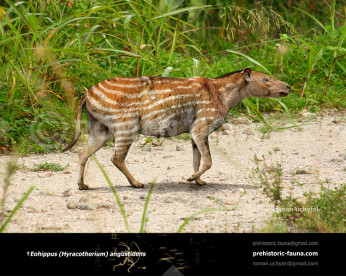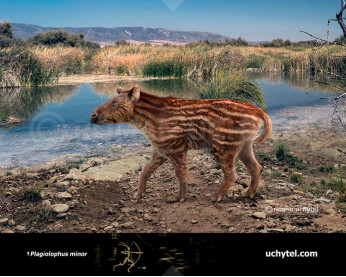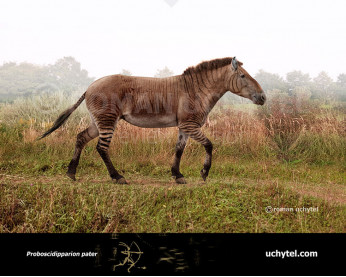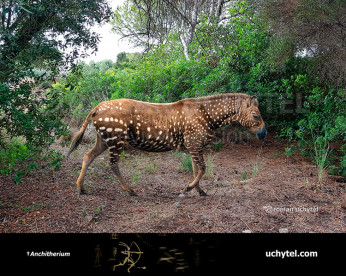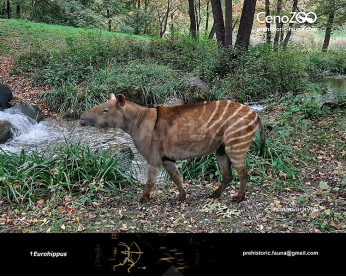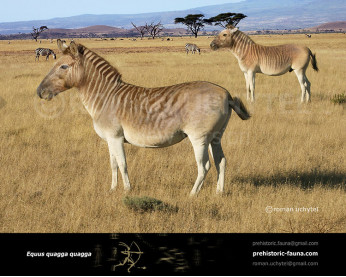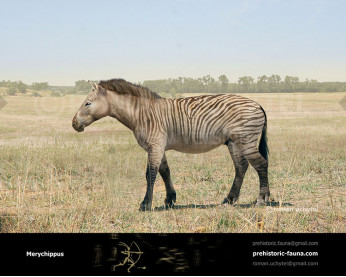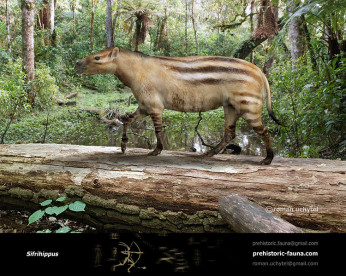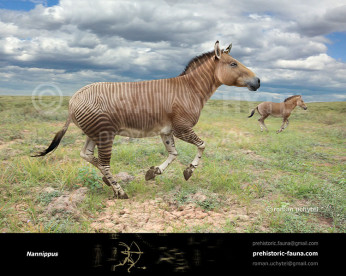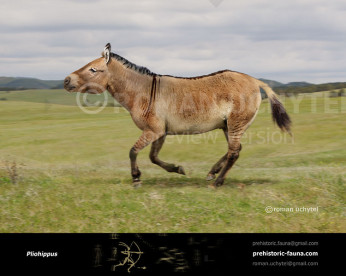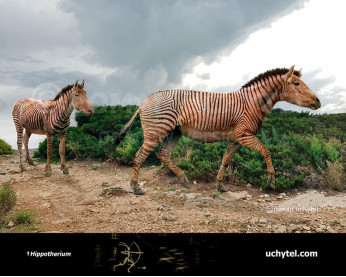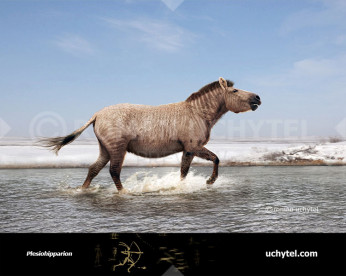Hipparion primigenium
176176Hipparion (Hipparion de Christol, 1832)
Order: Perissodactyla
Family: Equidae
Dimensions: length - 2 m, height - 120-140 сm, weight ~ 130-200 kg
Temporal range: during the late Miocene to late Pliocene (North America, Eurasia and Africa)
A typical representative: Hipparion primigenium Meyer, 1829
Hipparion was one of the earlier grazing horses that was similar to Merychippus in form. Like other ‘advanced’ horses of the Miocene, Hipparion supported its body weight upon a single toe that ended with a hoof. Other toes were also still present upon either side of this toe, but they had become so reduced in size that they did not even touch the ground. In later forms like Pliohippus the toes would be virtually absent.
Hipparion was about 1,2 - 1.4 metres tall at the shoulder. The key to fame for Hipparion is the amazing success that this genus exhibited. Although perhaps nothing special in terms of appearance, Hipparion appeared at the start of the Miocene period and continued to thrive until well into the mid Pleistocene, surviving for some twenty-two million years. In the space of this time Hipparion colonised most of the major continents with the exception of Antarctica, Australia and South America.
Hipparion would have been a horse of open plains and steppe, a far cry from its browsing ancestors that would have lurked amongst the bushes hiding from predators. The key adaption that Hipparion had for these habitats were high crowned teeth that were better suited for processing grasses which would have formed the most abundant type of plant that also readily replenished itself.
Despite its success after the Miocene, Hipparion was living in a world that saw the emergence of more advanced horses, all the way up to the point where the modern forms began to appear. These new forms as well as other new grazing animals such as mammoths would have meant increased competition for the same resources that Hipparion used. There is of course the consideration of the emergence of new predators such as cave hyena which seems to have actively hunted horse by the greater numbers of horse remains compared to other animals found in association with them. All of these new animals appearing would have gradually edged Hipparion into extinction long before the near total disappearance of the megafauna at the end of the Pleistocene.
Hipparion (Hipparion de Christol, 1832)
Order: Perissodactyla
Family: Equidae
Dimensions: length - 2 m, height - 120-140 сm, weight ~ 130-200 kg
Temporal range: during the late Miocene to late Pliocene (North America, Eurasia and Africa)
A typical representative: Hipparion primigenium Meyer, 1829
Hipparion was one of the earlier grazing horses that was similar to Merychippus in form. Like other ‘advanced’ horses of the Miocene, Hipparion supported its body weight upon a single toe that ended with a hoof. Other toes were also still present upon either side of this toe, but they had become so reduced in size that they did not even touch the ground. In later forms like Pliohippus the toes would be virtually absent.
Hipparion was about 1,2 - 1.4 metres tall at the shoulder. The key to fame for Hipparion is the amazing success that this genus exhibited. Although perhaps nothing special in terms of appearance, Hipparion appeared at the start of the Miocene period and continued to thrive until well into the mid Pleistocene, surviving for some twenty-two million years. In the space of this time Hipparion colonised most of the major continents with the exception of Antarctica, Australia and South America.
Hipparion would have been a horse of open plains and steppe, a far cry from its browsing ancestors that would have lurked amongst the bushes hiding from predators. The key adaption that Hipparion had for these habitats were high crowned teeth that were better suited for processing grasses which would have formed the most abundant type of plant that also readily replenished itself.
Despite its success after the Miocene, Hipparion was living in a world that saw the emergence of more advanced horses, all the way up to the point where the modern forms began to appear. These new forms as well as other new grazing animals such as mammoths would have meant increased competition for the same resources that Hipparion used. There is of course the consideration of the emergence of new predators such as cave hyena which seems to have actively hunted horse by the greater numbers of horse remains compared to other animals found in association with them. All of these new animals appearing would have gradually edged Hipparion into extinction long before the near total disappearance of the megafauna at the end of the Pleistocene.

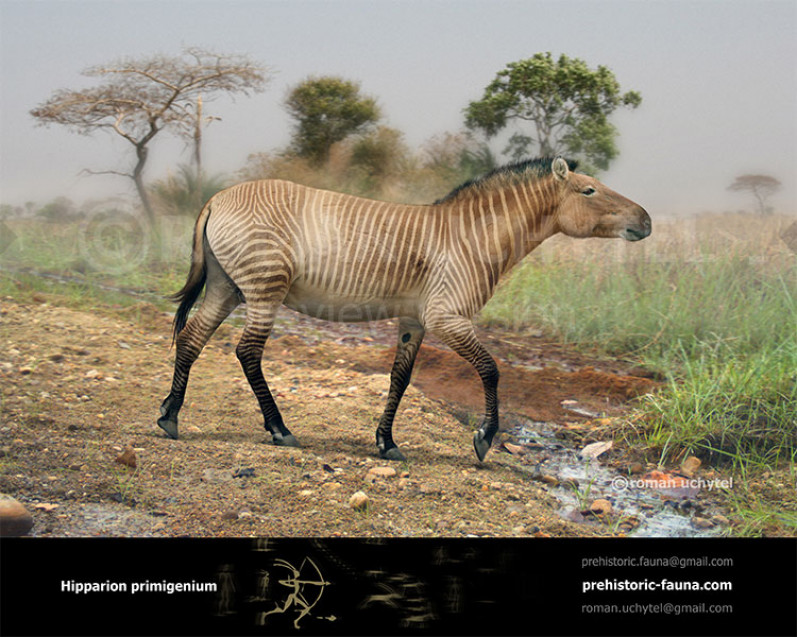
-797x638.jpg)
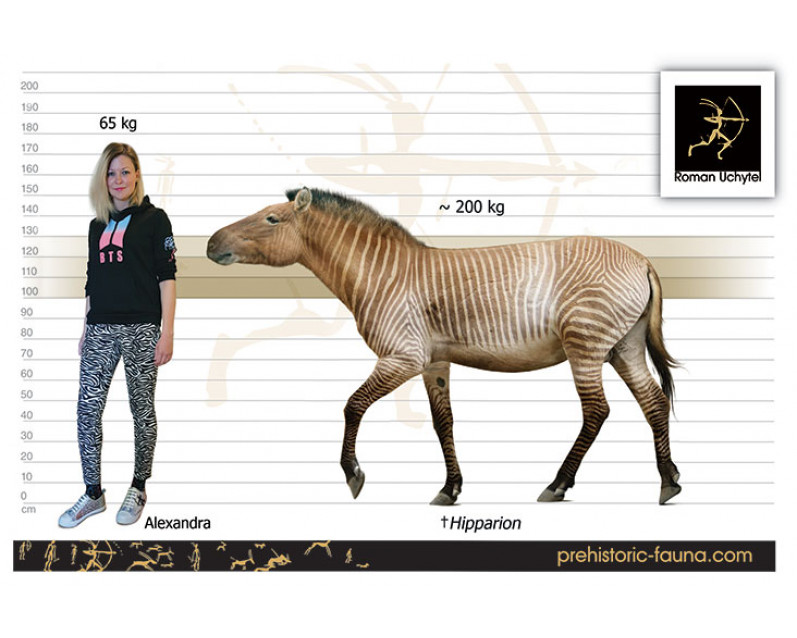

-70x56.jpg)

